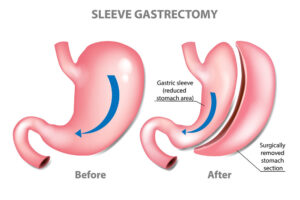In recent years, the pursuit of effective weight loss solutions has led to a growing interest in various treatments and procedures. Among the most popular options are Ozempic, liposuction, and the gastric sleeve. These three approaches are distinctly different but often find themselves compared due to their common goal of helping individuals achieve healthier bodies. However, they differ significantly in their methods, outcomes, and overall impact on the body.
Ozempic: A Medical Approach to Weight Loss
Ozempic, a medication primarily used to treat type 2 diabetes, has gained significant attention for its ability to promote weight loss. The active ingredient in Ozempic is semaglutide, a GLP-1 receptor agonist. This medication works by mimicking a hormone that regulates blood sugar and appetite, helping patients feel fuller for longer and reducing their food intake. As a result, Ozempic has proven effective for people who are overweight or obese, offering a non-invasive option for weight management.
Unlike surgery or cosmetic procedures, Ozempic is taken as an injectable medication once a week, making it an attractive alternative for those seeking a less invasive option. It’s important to note that while Ozempic can be effective in promoting weight loss, it should be used in conjunction with lifestyle changes like diet and exercise. Additionally, once the medication is discontinued, weight gain can occur, making it essential for individuals to maintain healthy habits long-term.

Liposuction: Sculpting the Body through Surgery
Liposuction is one of the most well-known cosmetic surgical procedures designed to remove excess fat from targeted areas of the body. Commonly performed on areas such as the abdomen, thighs, arms, and hips, liposuction uses a suction technique to break down and remove fat cells from the body. Unlike Ozempic and gastric sleeve surgery, liposuction is not a weight loss solution but rather a body contouring procedure. It is designed for individuals who are already at or near their target weight but are struggling with localized fat deposits that are resistant to diet and exercise.
Liposuction is a cosmetic procedure and is not meant to be a substitute for weight loss. While it can lead to a more toned and sculpted appearance, it does not address the underlying causes of weight gain or promote long-term weight loss. Additionally, it’s important to recognize that liposuction has its risks, including complications from anesthesia, infection, and skin irregularities. As with any surgery, it requires a period of recovery, and results may vary depending on the individual.
Gastric Sleeve: A Surgical Approach to Sustainable Weight Loss
The gastric sleeve, also known as sleeve gastrectomy, is a weight loss surgery designed for individuals who are severely obese and have not been successful with other weight loss methods. This procedure involves the removal of a large portion of the stomach, leaving behind a smaller, sleeve-shaped stomach about the size of a banana. With less stomach capacity, individuals feel full after eating smaller portions, leading to reduced calorie intake and significant weight loss over time.
Unlike liposuction, which only targets fat removal in specific areas, the gastric sleeve is a major surgery that alters the anatomy of the digestive system. It is typically performed laparoscopically, meaning it requires small incisions and has a shorter recovery time compared to more invasive surgeries. The gastric sleeve has been shown to result in substantial and sustained weight loss, with many patients losing 60-70% of their excess weight within two years.
However, it’s crucial to recognize that the gastric sleeve is not a quick fix. It requires ongoing lifestyle changes, including dietary adjustments and regular exercise, to maintain results. Moreover, patients must be committed to lifelong follow-up care to avoid potential complications, such as nutrient deficiencies or digestive issues.

Similarities Between Ozempic, Liposuction, and Gastric Sleeve
While these three weight loss solutions differ significantly in their methods, they share some similarities:
- Goal-Oriented: All three options are designed to help individuals achieve significant weight loss or improve body shape. Whether through medication, surgery, or cosmetic procedures, each approach aims to enhance the individual’s physical health and appearance.
- Lifestyle Changes: Regardless of the method chosen, all three require the individual to commit to a healthier lifestyle. For Ozempic users, this includes maintaining a balanced diet and exercise routine. After liposuction or gastric sleeve surgery, patients must make long-term dietary changes to prevent weight regain and optimize results.
- Non-Temporary Results (With Maintenance): Both liposuction and the gastric sleeve offer relatively permanent results when combined with a healthy lifestyle, while Ozempic provides ongoing benefits as long as it is being used. However, if lifestyle changes aren’t sustained, the effects of all three methods can diminish over time.
Key Differences Between Ozempic, Liposuction, and Gastric Sleeve
Despite the similarities, there are notable differences between these options:
- Invasiveness: Ozempic is a non-invasive, injectable medication. Liposuction is an invasive cosmetic surgery that removes fat, while the gastric sleeve is a major surgery that alters the digestive system.
- Target Area: Liposuction specifically targets localized fat deposits, while Ozempic and gastric sleeve surgery aim to promote overall weight loss or reduce stomach capacity.
- Long-Term Commitment: While liposuction provides immediate body contouring results, both Ozempic and gastric sleeve require long-term management. Ozempic relies on consistent use of medication, and gastric sleeve surgery requires ongoing lifestyle changes and regular medical monitoring.
- Risk Factors and Recovery: Liposuction and gastric sleeve surgery come with inherent risks, including infection, complications from anesthesia, and potential for nutrient deficiencies in the case of the gastric sleeve. Ozempic, on the other hand, is associated with minimal risks, though side effects like nausea, digestive issues, and potential long-term impacts on the pancreas have been noted.
Conclusion: Choosing the Right Solution for You
Ultimately, the choice between Ozempic, liposuction, and gastric sleeve surgery depends on an individual’s specific needs, goals, and medical history. Ozempic is an ideal choice for those seeking a less invasive method for weight management, while liposuction is best suited for individuals who want to target specific areas of fat. The gastric sleeve is a more drastic option for those struggling with severe obesity and a history of failed weight loss attempts.
Before making a decision, it’s crucial to consult with a healthcare provider to assess which method aligns with your overall health and weight loss goals. With the right guidance, these treatments can serve as powerful tools in the journey toward a healthier, more confident you.
